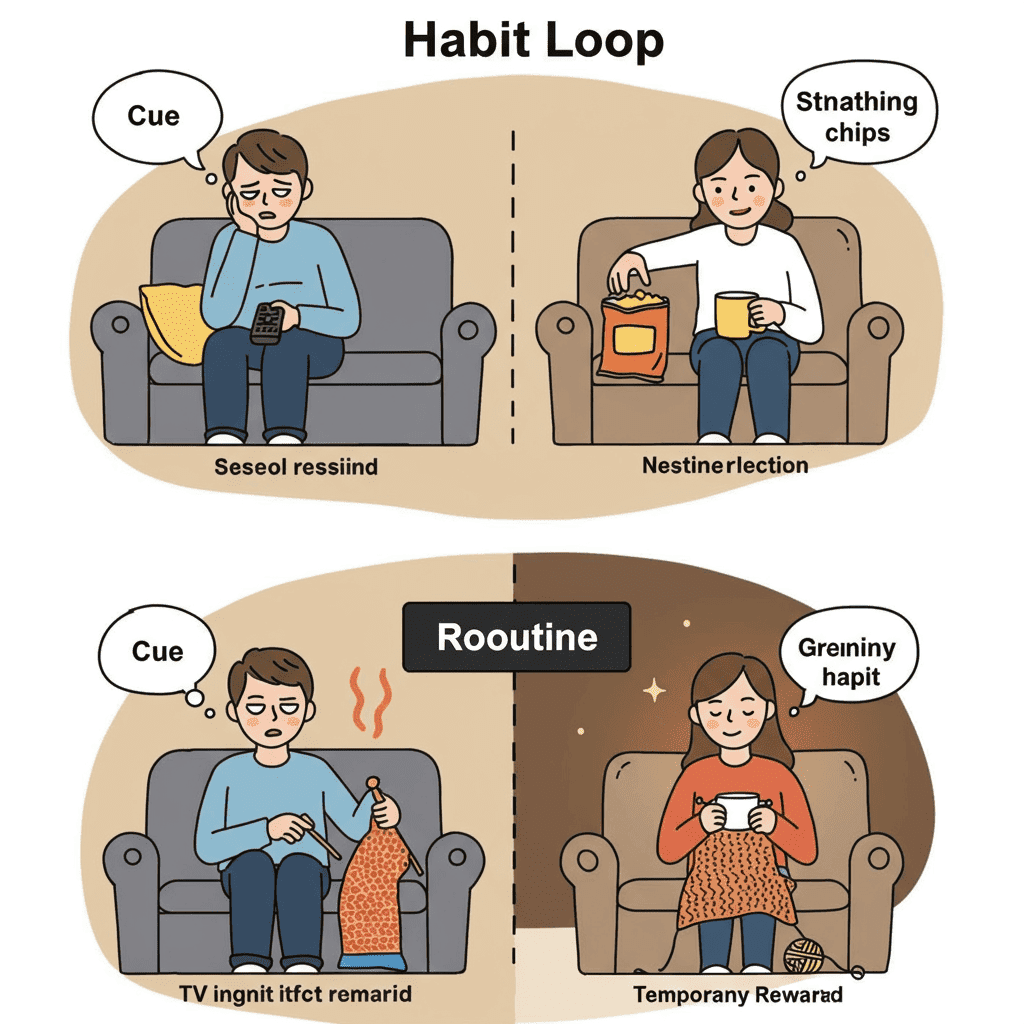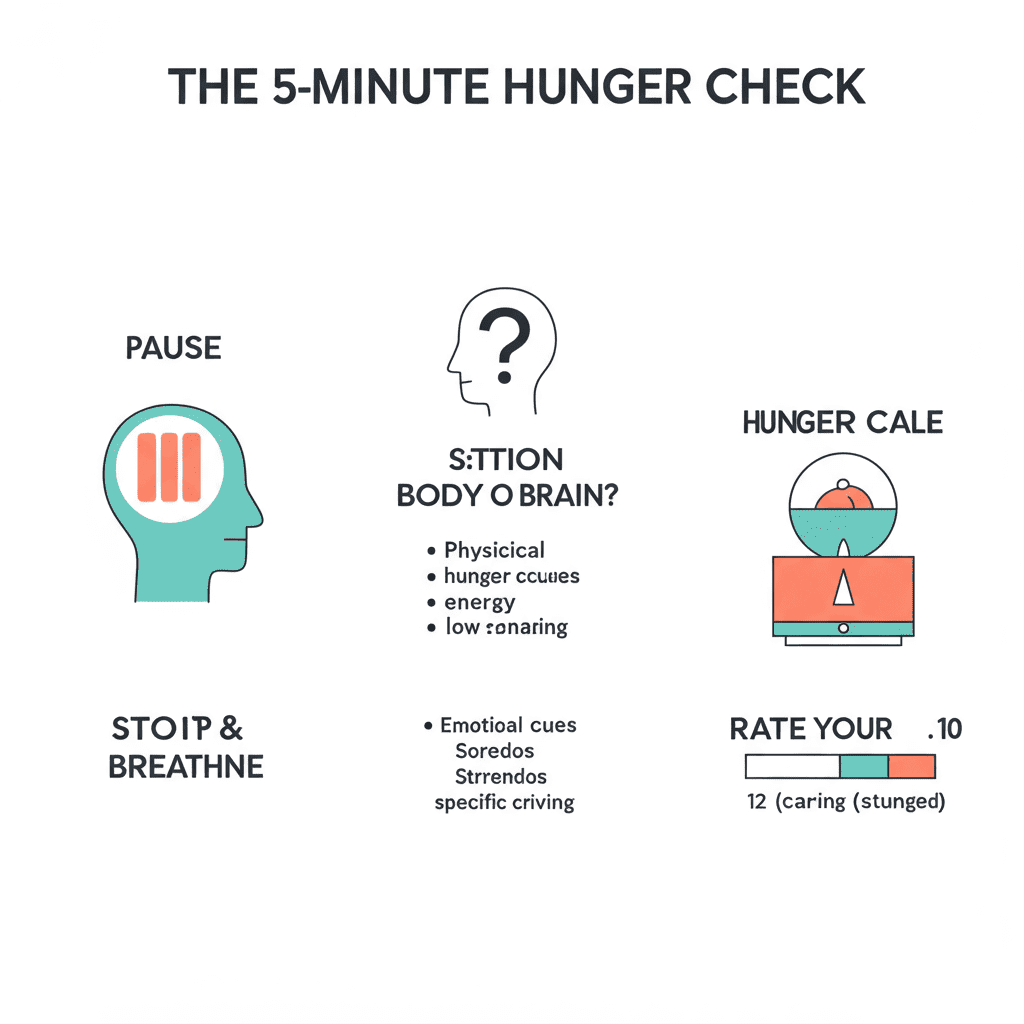Are You Really Hungry? What to Do Instead of Mindless Eating

You find yourself standing in front of the open refrigerator, its cool light washing over your face.
You’re not sure what you’re looking for, and you just had dinner about an hour ago.
You’re not hungry, but you feel a strong, almost magnetic pull to just…
eat something.
If this scenario sounds familiar, you are not alone.
As a Registered Dietitian, I work with clients every day to move past this cycle of mindless eating.
The solution isn’t about willpower or restriction; it’s about understanding the ‘why’ behind your urges.
This guide will help you decode your body’s signals and give you actionable, compassionate strategies to use when you feel like eating, but you know you’re not truly hungry.
What’s Really Behind That Urge to Eat?

Before we can find effective alternatives, we first have to understand what’s driving the urge.
It’s rarely a lack of willpower.
More often, it’s a mix of biology and psychology.
Our brains are wired to seek pleasure and comfort, and for many, food is the most accessible source.
Researchers differentiate between two types of hunger: Homeostatic Hunger: This is your body’s true, physical need for energy.
It’s controlled by physiological signals, like the hormone ghrelin, which sends ‘I need fuel’ messages from your stomach to your brain.
This type of hunger builds gradually and is satisfied by any number of foods.
Hedonic Hunger: This is the drive to eat for pleasure, driven by the brain’s reward system.
A 2018 study in the journal Neuropsychopharmacology highlights how exposure to highly palatable foods can trigger dopamine release, making you want to eat even when you have no physical need for calories.
This ‘head hunger’ is often triggered by emotions.
The Mayo Clinic notes that emotions like stress, boredom, and sadness can create a perceived void that food seems to fill, providing a temporary distraction or a soothing sensation.
Recognizing whether your urge is coming from an empty stomach or an unfulfilled emotion is the first step.
How Can You Tell If It’s Real Hunger?

When an urge to eat strikes, the most powerful tool you have is the pause.
Instead of reacting automatically, you can create a space for conscious choice.
I call this the ‘Pause and Assess’ technique, a cornerstone of mindful eating.
Here’s how to do it: Step 1: Stop and Take Five.
Commit to not eating for just five minutes.
Set a timer if you need to.
Remove yourself from the kitchen or the source of food.
This short delay is often enough to break the impulsive reaction.
Step 2: Ask, ‘Where Am I Feeling This?
‘ Tune into your body.
Physical hunger is usually felt in the stomach.
You might notice emptiness, growling, low energy, or a slight headache.
It came on gradually.
Emotional or habitual hunger is often felt ‘from the neck up.
‘ It’s a craving for a specific taste or texture.
You might feel tension in your shoulders or a sense of restlessness.
It likely appeared suddenly.
Step 3: Rate Your Hunger.
On a scale of 1 (starving) to 10 (uncomfortably stuffed), where are you?
True physical hunger typically registers between a 3 and 5.
If you’re at a 6 or 7, it’s almost certainly not physical hunger.
According to research on interoceptive awareness—the ability to perceive the internal state of your body—practicing this self-scan strengthens the mind-body connection over time, making it easier to distinguish real hunger from its impostors.
A study in the journal Appetite (2015) found that higher interoceptive awareness is linked to more intuitive eating behaviors, and keeping a journal can be a powerful way to track your progress. For more on this, see our dietitian’s guide to journaling for your health goals.
What Can You Do Instead of Emotional Eating?

If your ‘Pause and Assess’ check reveals you’re looking for comfort, distraction, or stress relief, food will only provide a temporary patch.
The key is to match the activity to the underlying emotional need.
If You’re Feeling Stressed or Anxious: Your body is looking for a way to release nervous energy.
Instead of crunchy chips, try something that calms your nervous system.
Activity: Go for a brisk 10-minute walk, put on a high-energy song and dance, or do a few rounds of deep box breathing (inhale for 4 counts, hold for 4, exhale for 4, hold for 4).
Why it works: Physical activity is a proven way to process stress hormones like cortisol, according to Harvard Health.
If You’re Feeling Sad or Lonely: You’re likely craving comfort and connection.
Activity: Make a warm, non-caffeinated drink like herbal tea or a golden milk latte.
Call or text a friend you trust.
Snuggle under a weighted blanket or with a pet.
Why it works: These activities provide sensory comfort and can trigger the release of oxytocin, the ‘connection’ hormone, which directly counters feelings of loneliness.
If You’re Feeling Bored: Your brain is seeking stimulation.
Activity: Listen to an engaging podcast, work on a puzzle or crossword, organize one small drawer, or watch a short, interesting documentary on YouTube.
* Why it works: These tasks provide the mental engagement your brain is craving, which is a more direct fix than the passive stimulation of eating.
What If You’re Just Eating Out of Habit?

Sometimes, you eat not because of emotion, but because of pure habit.
The 8:00 PM TV-and-snack ritual is a classic example.
According to research popularized in ‘The Power of Habit’ by Charles Duhigg, habits follow a neurological loop: Cue -> Routine -> Reward.
Cue: Sitting down on the couch to watch TV.
Routine: Going to the pantry to grab a bag of chips.
Reward: Oral fixation, sensory pleasure (salty, crunchy), and satisfying the learned association.
To break the cycle, you don’t fight the cue; you change the routine.
Keep the cue (watching TV) and the reward (sensory satisfaction), but swap the routine.
Try These Habit Swaps: To replace oral fixation: Sip on a flavorful seltzer, sparkling water with lemon, or a hot decaf tea.
To keep your hands busy: Try knitting, working on an adult coloring book, or using a small piece of therapy dough.
To get the ‘treat’ reward: Plan a non-food reward for the end of the night, like reading a chapter of a great book or taking a relaxing bath.
By consciously choosing a new routine, you can rewire the habit loop over time to serve your goals instead of undermining them.
Is It Ever Okay to Eat When You’re Not Hungry?

After everything we’ve discussed, you might wonder if you should never eat unless you’re physically hungry.
As a dietitian who champions a non-restrictive approach, the answer is a resounding no.
Food is more than fuel; it’s culture, it’s pleasure, it’s connection, and it’s celebration.
The goal of mindful eating is not to achieve a perfect record of only eating for physical hunger.
The goal is awareness.
It is absolutely okay to: Eat a piece of birthday cake at a party when you’re not hungry.
Enjoy a scoop of ice cream on a hot day just for the joy of it.
* Share a dessert with a loved one as a bonding experience.
The difference is making a conscious choice.
Instead of mindlessly finding yourself at the bottom of a bag of chips, you are actively deciding, ‘I’m not hungry, but I am choosing to eat this because it is a special occasion, and I want to enjoy it.
‘ This awareness removes the guilt and allows you to savor the experience, which is a key part of a healthy, balanced relationship with food.
Conclusion
Building a healthier relationship with food isn’t about creating a long list of rules or feeling guilty.
It’s about building awareness.
The goal isn’t to perfectly avoid non-hunger eating forever, but to understand why it’s happening and feel empowered to make a conscious choice.
By tuning into your body’s true needs—whether that’s nourishment, comfort, or stimulation—you can respond in a way that truly satisfies you.
This is the foundation of a peaceful, sustainable approach to eating that supports your overall well-being.
